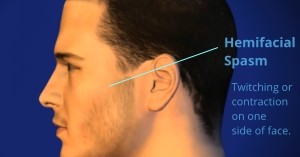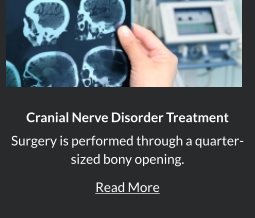Hemifacial Spasm Newport Beach & Orange County, CA
Hemifacial Spasm Treatment in Orange County
 Hemifacial spasm is characterized by continuous involuntary twitching or contraction of muscles on one side of the face, which usually begins around the eye and spreads to the cheek and mouth. This condition is painless and cannot be controlled by any oral medications.
Hemifacial spasm is characterized by continuous involuntary twitching or contraction of muscles on one side of the face, which usually begins around the eye and spreads to the cheek and mouth. This condition is painless and cannot be controlled by any oral medications.
The hemifacial spasm can be caused by injury to the facial nerve, a tumor, or a blood vessel compressing the nerve. The most common cause is compression of the facial nerve by the anterior inferior cerebellar artery at the point where it emanates from the brain stem. The compression causes the nerve to misfire making your facial muscles contract or twitch. This condition is also related to trigeminal neuralgia—a condition arising from the fifth cranial nerve that causes severe facial pain.
Your Orange County neurosurgeon Robert Louis, MD will carefully review your medical history and perform a neurological exam. An MRI scan may be ordered to rule out other conditions such as a brain tumor, aneurysm, or AVM that may be causing facial nerve compression. Next, you may have an EMG study of the face.
Magnetic resonance imaging (MRI): An MRI uses magnetic fields to produce detailed images of the body. A special dye called a contrast medium is injected into a patient’s vein before the scan to create a clearer picture.
Electromyogram (EMG): An EMG is often done along with a nerve conduction velocity (NCV) study to measure your muscle and nerve electrical activity.
Minimally Invasive Keyhole Approach
Robert Louis, MD performs this operation is performed through a quarter-sized bony opening using endoscopic techniques. This keyhole approach preserves the surrounding normal structures as best as possible. Depending on the nerve affected, various other therapies may be indicated. By incorporating cutting-edge technology and instrumentation with proven surgical experience, we make surgery safer, less invasive, and more effective. Learn more about cranial nerve disorders.
Robert Louis, MD specializes in minimally invasive removal of chordoma. Less invasive keyhole surgical approaches incorporate Dr. Louis’ experience and education with cutting-edge technology and instrumentation.
Retomastoid Approach-Facial nerves and blood vessels may be approached directly using the Retromastoid Approach. Robert Louis, MD specializes in this state-of-the-art, minimally invasive keyhole approach to accessing cranial nerves and blood vessels through a small bony opening behind the ear. This approach incorporates cutting-edge technology and instrumentation with Dr. Louis’s surgical experience and training, making surgery safer, less invasive, and more effective.Read more about Retromastoid Approach.
Robert Louis, MD, a fellowship-trained Orange County Neurosurgeon, is the Director of the Skull Base and Pituitary Tumor Program at Hoag Memorial Hospital in Orange County, California. Dr. Louis has particular expertise in the endoscopic and minimally invasive treatment of benign and malignant brain tumors, sellar and parasellar tumors, and skull base tumors.
Dr. Robert Louis specializes in minimally invasive brain surgery for the treatment of chordoma. For appointments, please call (949) 383-4185 or Contact Us.
















